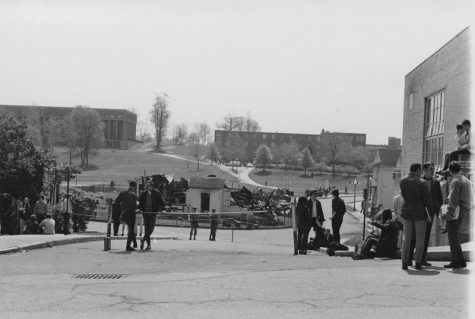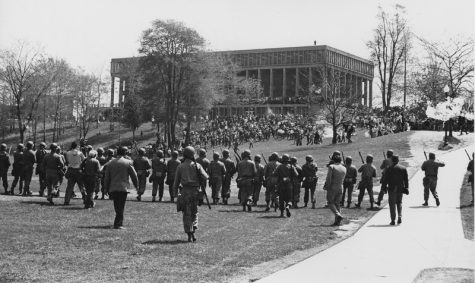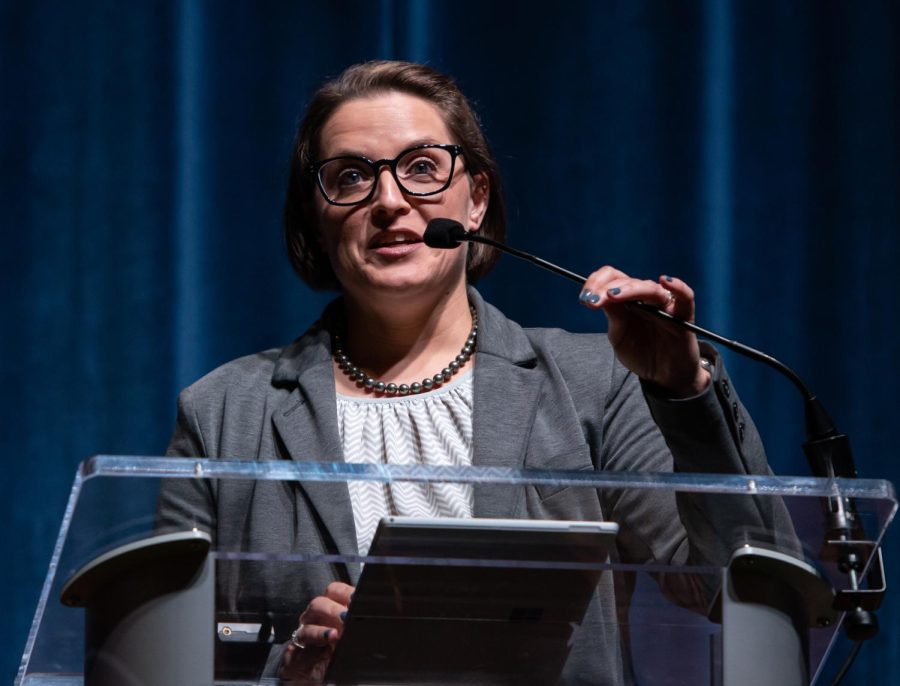‘Where Were the Administrators? A Student Affairs Perspective on May 4’ lecture
Lecturer and assistant professor Erica Eckert speaks on what the Kent administration was doing during and leading up to the May 4 shooting May 3, 2023.
May 4, 2023
Assistant professor of higher education Erica Eckert discussed how the university’s administration handled the events surrounding the May 4 shootings in her Thursday lecture titled “Where Were the Administrators? A Student Affairs Perspective on May 4, 1970.”
Eckert’s research relied on oral history and interviews from former residence hall directors, student affairs administrators and other officials to gain an understanding as to what those administrators were doing during the events of May 4 to keep students safe.
Eckert said her interest in May 4 began when she took a class about May 4 as a graduate student in higher education administration at Kent State, where she studied university operations and the tools for student success.
“As I built my understanding, I found myself wondering how the national guard came to be put in charge of a college campus?” she said. “As a person studying how to run a college or university, I wondered, ‘Where were the administrators? What were they thinking? Matter still, what were they doing?’”
Ten years after she graduated, Eckert met Ron Beer, who was then university President Robert White’s executive assistant in 1970, she began collecting information on what the university’s administrators were doing at the time of the shootings.
“I positioned my inquiry to respond to the question posed by leading May 4 scholars Jerry Lewis and Thomas Hensley, ‘Did the Kent State University administration respond appropriately in their reactions to the demonstration and with Ohio political officials and guard officials’,” she said.
To make the scope of her study manageable, Eckert chose to focus on student affairs and examined the definition of emergency management, or a “contingency plan,” and what classifies an event as a disaster.
Eckert viewed the actions of the administrators through a current day emergency management lens. She examined five phrases of emergency management.
“The first phase planning is the designation of resources to work on crisis planning, the prevention step is to activate crisis mitigation through forecasting and reduction of risks and developing the actual crisis plan,” said Eckert. “The response step is following the plan when the crisis occurs. Recovery and learning happen in the aftermath. Crises also require effective cooperation.”
To talk about the events that occurred on May 4, Eckert wanted to ensure that the audience understood the amount of change that occurred at Kent in the 1960s.
Eckert said the university’s student population grew from under 10,000 students in 1959 to nearly 30,000 students in 1969. With a large student body, Kent State created its Student Affairs office in 1968.
After the protests that occurred during the 1968-69 academic year, the student affairs administration updated its protocol to require staff present at demonstrations.
The university created a command center to collect information and collaborated with the Ohio Highway Patrol to have them present at student demonstrations.
“Steven Sivulich, assistant director of student conduct, described his responsibility as a present moderator as, ‘Being present for any type of gathering that occurred on campus and reporting potential problems to the vice president for student affairs, office of student conduct and or university police,’” Eckert said.
She noted Sivulich said he had no training in crowd control, student disturbances or civil disobedience. Sivulich later described the Friday, May 1 afternoon anti-Vietnam protest as “nothing too drastic.”
Eckert said this made President White feel comfortable leaving the campus for Iowa that night.
On Saturday morning, the student affairs staff met in their command room after hearing rumors about what would eventually occur Saturday night and began organizing events to keep campus busy, such as musical acts, film festivals and a movie screening, within the curfew that was set.
The Student Affairs Office created a rumor control center to keep students informed. Director of resident halls Joe LaCamera informed Eckert students “were getting all kinds of information and I don’t think they know what to do with it.’”
Faculty member Jerry Lewis, who volunteered to work in the rumor control center, echoed LaCamera’s sentiments when talking to Eckert.
“We sat there for two hours spreading rumors, we didn’t know anything,” he told Eckert.
Vice President of Student Affairs Robert Matson told Eckert he was told if the National Guard were called to campus, they would make no distinction between the city and campus.
Matson then created a curfew for students and advised President White to return to campus while the first groups of the National Guard troops arrived in Kent.
During this time, as the ROTC building near the now-D.I. Hub was set on fire by protesters, the Student Affairs administration was at work.

“Student affairs personnel were trying to keep students inside residence halls and away from the ROTC building,” Dave Ambler, vice president of student affairs at the time, told Eckert. “Dave explained, ‘They were trying to keep order out of what was pretty much too chaos at this point.’”
The following morning, Governor James Rhodes arrived on campus to deliver a press conference. He met with university administration and others prior to his address.
“Dave Ambler described it as, ‘a private meeting with city officials, guard leadership, Kent city police, Kent State policy and about five or six university administrators,’” Eckert said.
At the meeting, Rhodes informed the group that he gave the National Guard authority to control the situation and informed the university authorities they are no longer part of the situation.
Eckert said residence halls directors attempted to keep students safe with the guard present.
“Richard Herdlein, a residence hall director for Dunbar described guardsmen with bayonets chasing, ‘forty or fifty students running toward Dunbar Hall, and I had to make choice to open the door and then lock it so the guard couldn’t get in’,” Eckert quoted from Herdlein.
The following morning on May 4, Kent State leaders left campus to hold a meeting about regaining control from the guard. Eckert asked those like Matson why they left campus.
“We had to have permission to have a meeting on campus and that was ridiculous,” Matson had said.
Over lunch, they came to the conclusion to close the campus but then received a phone call informing them about the shootings.

Residence hall directors informed residents to stay far from the commons as they helped injured students.
“Richard Herdlein was outside Prentice Hall and saw the guard turn and fire across the parking lot and then helped load an injured student into an ambulance,” Eckert said.
After the shootings, the university closed and students were evacuated through Kent’s bus fleet.
“We sent the buses primarily to the residence halls but also picked up kids along the way and those dormitories empty out, and it seemed to me like it was two hours,” Matson told Eckert.
Although the administration’s attempts to keep students safe were halted by Governor Rhodes misevaluation of the situation, the events of May 4 have inspired other universities and colleges to adapt contingency plans, Eckert said.
Eckert said she hopes listeners gained the skill of situational awareness from her lecture.
“Engage with the people around you,” she said. “If you’re in your job, engage with your co-worker, build relationships so that you maintain situational awareness of what’s hoping because that would have helped the administrators at Kent State. They did everything they could in that moment but, even they will tell me, ‘I wish I did more.’ Always try to maintain awareness of what people are feeling, thinking and caring about.”
Adriana Gasiewski is a reporter. Contact her at [email protected].












